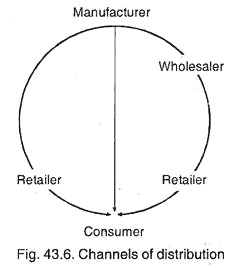This article throws light upon the three important marketing intermediaries in the channels of distribution. The intermediaries are: 1. Retailers 2. Wholesalers 3. Market Logistics.
Marketing Intermediary # 1. Retailing:
Retailing includes all the activities involved in selling goods or services directly to final consumers for their personal, non-business use. A retailer or retail store is any business enterprise whose sales volume comes primarily from retailing.
Retailers can be classified in terms of store retailing, non-store retailing, and retail organisations. The major types of retail stores are speciality stores, department stores, supermarkets, convenience stores, superstores, and catalogue showrooms.
Retailers purchase the products from the wholesalers and then sell in small lots or in piece meals to the consumers.
ADVERTISEMENTS:
Retailers are of following types:
(A) Moving Retail Dealers:
This type of retail dealers do not have fixed business premises and move from place to place for selling goods to the consumers.
Some of the dealers of this type are:
ADVERTISEMENTS:
(i) Hawkers:
These petty dealers move from door to door in residential colonies.
(ii) Pavement Shop Dealers:
These dealers arrange their goods on pavement of busy streets.
(B) Fixed Shop Retailers:
Unlike the moving retailers, these retailers do their business in fixed shops, but in small scale.
Various types of small scale retail shops are:
(i) Street stalls:
ADVERTISEMENTS:
These stalls are located in the streets.
(ii) General Stores:
These stores stock a wide variety of product needed by the local residents frequently.
(iii) Single Line Stores:
ADVERTISEMENTS:
Such stores located in urban areas deals in a particular line only instead of dealing in variety of lines of products. For example, cloth merchants deal only in clothes, chemists deals only in medicines, hosiery shop deals only in hosiery items.
(iv) Specialty Shops:
Such shops deal only in special items of a particular line. For example a cloth dealer may deal only sarees, or in suitings-shirtings or woollen cloth or in bed sheets, or in blankets only.
Marketing Intermediary # 2. Wholesaling:
Wholesaling includes all the activities involved in selling goods or services to those who buy for resale or business use. Manufacturers use wholesalers (also called distributors) because wholesalers can perform functions better and more cost effectively than the manufacturers can.
ADVERTISEMENTS:
These functions include selling and promoting, buying and assortment building, bulk-breaking, warehousing, transportation, financing, risk bearing, dissemination of market information, and provision of management services and consulting.
Marketing Intermediary # 3. Market Logistics:
Market logistics involves planning, implementing and controlling the physical flow of materials and final goods from points of origin to points of use to meet customer requirements at a profit. Information system plays a critical role in managing market logistics.
The logistical task is to coordinate the activities of suppliers, purchasing agents, manufacturers, marketers, channel members, and customers. The ultimate goal of market logistics is to meet customers’ requirements in an efficient and profitable way.
ADVERTISEMENTS:
Market logistics managers are required to take following major decisions:
(i) How should orders be handled? (Order processing).
(ii) Where should stocks be located? (Warehousing).
(iii) How much stock should be held? (Inventory).
(iv) How should goods be shipped? (Transportation).
Choice of Channel:
ADVERTISEMENTS:
Channels of distribution is also called as trade channels or marketing channels. Each manufacturer usually adopts a number of alternative ways to make its product reach the consumers. They vary from direct selling to final user, using one, two, three or more intermediaries.
Factors affecting the choice of channels:
(i) Nature of Product:
Perishability, technical nature, cost, volume and weight etc.
(ii) Nature of Market:
ADVERTISEMENTS:
Consumer or industrial market, number of potential customers, geographical concentration of market, size of order etc.
(iii) Number and Types of Middlemen:
Availability and attitude of middlemen, sales volume, cost etc.
(iv) Competition
(v) Legal constraints
(vi) Nature and size of manufacturing concern.
